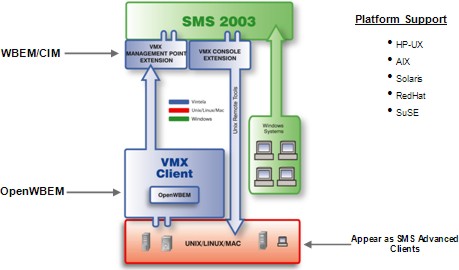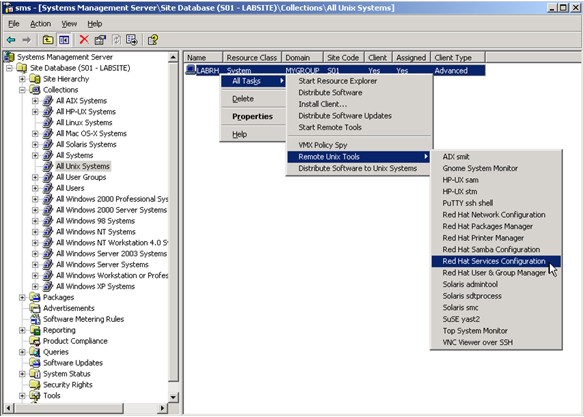Managing the Lab: SMS and our mixed environment
by admin on March 31, 2006 01:00pm
Getting the Open Source Software Lab up and running presented a number of challenges – not the least of which was how we were going to manage fifty Linux distributions, fifteen versions of UNIX, and multiple Windows instances deployed across literally hundreds of physical and virtual servers. This is quite a job for any management solution. Being the pragmatists we are, we decided to use this to test the viability of SMS (Microsoft Systems Management Server) using VMX (Vintela Management Extensions) in a mixed environment.
We deployed the solution and found it to be capable of handling our environment. Currently a large part of the lab is managed by SMS and VMX. When we describe this to people we are often asked, "Why does Microsoft supports this kind of solution? Why do we care about mixed environments?"
We asked Bill Anderson, Lead Program Manager on the Windows Management Team, and here is what he had to say:

Bill Anderson
Not really, but his lab is less camera-shy.
The first question I always get asked is, “what really was the catalyst for SMS to seek out a partner to provide extensions to OSS/Linux? Simple – our customers demanded it. Our existing SMS customers are managing both desktops and servers, and have a multitude of platforms in production in those environments and wanted to extend the success they have with SMS on Windows to those additional platforms. And, as we’re driving SMS into new customers, it has become one of the top requirements for customers – an integrated solution to manage all their critical platforms.

Now, the second driver was the WAY in which the market was doing cross-platform management. It’s, well, “suboptimal”. You either take 2 management systems (Windows mgmt, non-Windows mgmt) with their own array of servers, agents, and databases – and join the databases, or you try to take one agent that runs on all platforms, and you can then only join the things that are the same/similar. You either get a bunch of extra infrastructure with no leverage of skillsets, or you get a lowest common denominator management experience.
What we did was option 3 – build a single shared infrastructure that was extensible at the protocol, data, and UI layer, and then take the 2 leaders in the field to build from that same plumbing. So, we optimized our agents for the work on Windows, and we worked with the Vintela team as the experts in managing OSS/Linux to really optimize their experience for that platform. So, what does a customer get? 1 database, one UI, one protocol, and agents unique to each platform. Low operational cost, leveraged skillsets, and the opportunity for each vendor to really highlight the best they could do on each platform. Some of the things that Vintela can surface and manage on the Linux platform, using SMS as a pipeline, are pretty amazing! They’ve extended our UI to really expose all the remote functions available on Linux from the different vendors like Red Hat, SuSE, HP, and Sun. My challenge to them was to make Linux look BETTER in SMS than Windows does. We’ll try to make Windows more manageable by adding more, not by restricting. And the results are pretty compelling. As Andi put it in Network World's Network/Systems Management Newsletter: “Yes, you read that correctly - Microsoft tools can make Linux management easier. To its credit, Microsoft has made this easier through partnerships and programs like its Dynamic Systems Initiative - a commitment from Microsoft and its partners to deliver self-managing dynamic systems…(snip). This allows enterprises to leverage their investment in native Windows tools to make them a very effective management platform for diverse networks. “
How the Vintela solution works is really pretty simple. They take a WBEM based agent (they are the project maintainer for OpenWBEM) that runs on the major OSS platforms, that points at a URL that is our Management Point role. They extend our MMC based UI and voila – instant management for Linux! No database schema changes required, no separate middle infrastructure, etc. Initially, there was an ISAPI.dll “gateway” they had built to convert their agent protocol to ours at the Management Point, but we’ve worked to even eliminate that as they are now using our native protocols. As you can see, this is a slam dunk for a customer using SMS already to manage Windows that wants to extend it to manage Linux. It’s amazing to walk to an SMS admin, open their admin UI, have them see machine collections based on Linux versions/vendors, and be able to send software to a group of Linux machines in about 3-4 clicks. But, we’re even seeing customers use THIS as a solution for managing Linux only!

Vintela has done a great job of really just using the SMS UI, database, and pipes as their engine, and leveraging all the manageability on the native Linux platform to provide a great stand-alone tool for managing Linux. Inventory, software distribution, patch management and remote tools – all in one single UI and infrastructure. The other key is really leveraging the OpenWBEM work to provide consistent management on different Linux versions. The Vintela team has done a great job of driving consistency via OpenWBEM, but still leverage all the extra tools and functions provided by each Linux vendor. If I were managing Linux systems (not a lot of that around here by the way!) I’d definitely use it!
